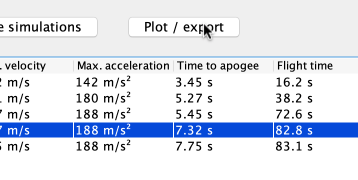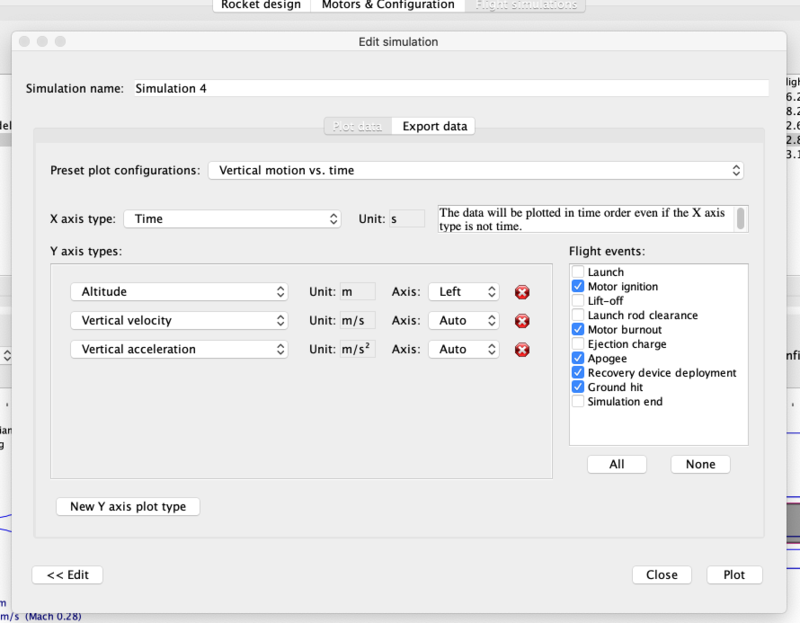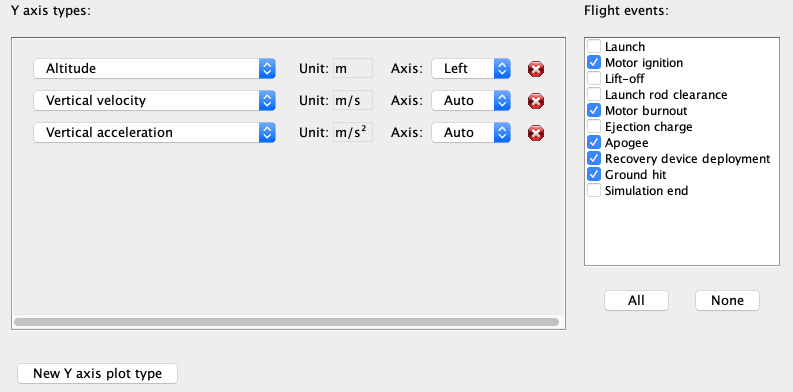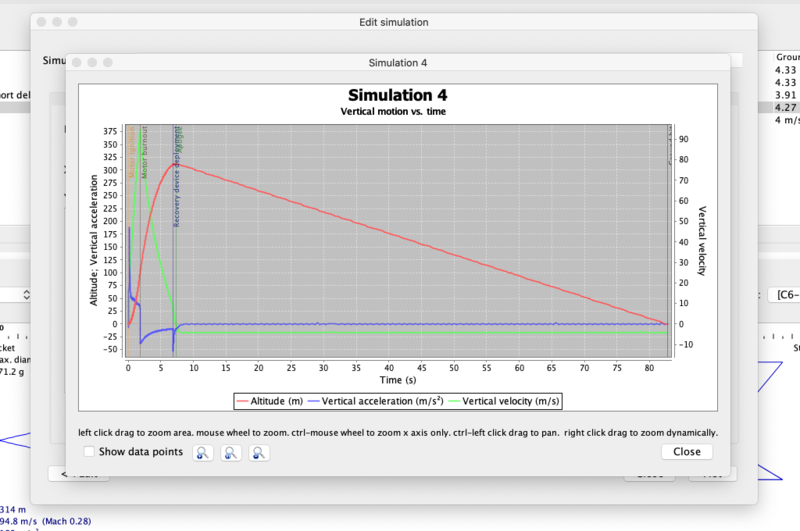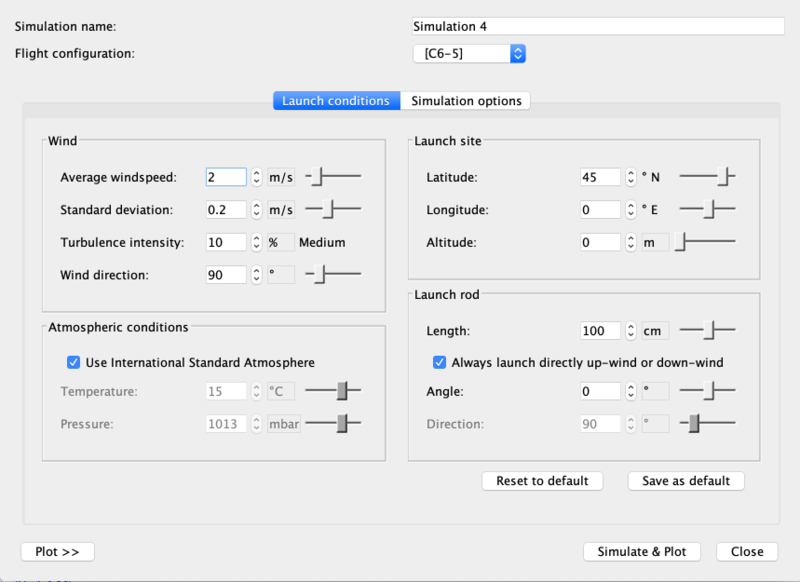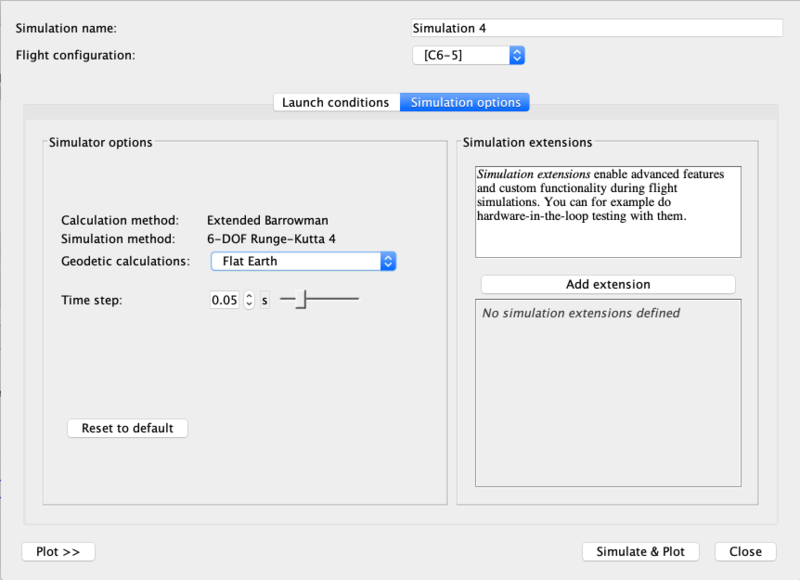Advanced Flight Simulation
|
The current User's Guide is very much a work in progress, any help would be greatly appreciated! |
Advanced Flight Simulation
OpenRocket offers more advanced options for simulating flight. You can plot your rocket's predicted acceleration, climb, eject and landing, make a prediction for how far downrange and in which direction your flight will land, and even experiment with different models of Earth's geometry, as it affects your flight. Once you're satisfied with a sim, you can export your data for analysis and charting in other packages.
Plotting your rocket's flight
To begin learning about OpenRocket's plotting features, first, click the Plot / Export button on the Flight simulations window.
On the Edit simulation panel, you'll see tabs marked Plot data and Export data. The Plot data opens first. Here you can define many parameters that will determine what values are plotted, and what events are marked on the plot.
Here you'll be able to quickly choose from a number of standard plots:
You'll also be able to assign to the X and Y axes any one of over 50 parameters:
- Time
- Altitude
- Vertical velocity
- Vertical acceleration
- Total velocity
- Total acceleration
- Lateral distance
- Lateral direction
- Lateral velocity
- Lateral acceleration
- Latitude
- Longitude
- Gravitational acceleration
- Angle of attack
- Roll rate
- Pitch rate
- Yaw rate
- Mass
- Propellant mass
- Longitudinal moment of inertia
- Rotational moment of inertia
- CP location
- CG location
- Stability margin calibers
- Mach number
- Reynolds number
- Thrust
- Drag force
- Drag coefficient
- Axial drag coefficient
- Friction drag coefficient
- Pressure drag coefficient
- Base drag coefficient
- Normal force coefficient
- Pitch moment coefficient
- Yaw moment coefficient
- Side force coefficient
- Roll moment coefficient
- Roll forcing coefficient
- Roll damping coefficient
- Pitch damping coefficient
- Reference length
- Reference area
- Vertical orientation (zenith)
- Lateral orientation (azimuth)
- Wind velocity
- Air temperature
- Air pressure
- Speed of sound
- Simulation time step
- Computation time
- Position parallel to wind
- Position upwind
You can assign multiple parameters to the Y-axis, and choose whether their scales appear on the left, or the right side of the plot. You can add Y-axis parameters with the New Y-axis plot type button, or delete parameters from the plot with the X buttons. (The X-axis takes only a single plotted parameter, typically Time).
Additionally, you can choose from several flight events, any or all of which can be called out on your plot, in reference to the simulated time of occurrence.
Below you can see a plot of A simple model rocket, simulation number 4, flying on a C6-5. Note that the five events checked in the above screen have been marked on the plot (some very close to each other, or to the edge): Motor ignition, Motor burnout, Apogee, Recovery device deployment, and Ground hit.
You can also see that the three Y-axis parameters described above: Altitude, Vertical velocity, and Vertical acceleration appear as lines of three different colors.
As your rockets get more complex, with features like dual-deploy, air-start and multiple stages, your plots can grow in complexity to simulate their expected behavior. Below is a plot (from the example rockets) of a "High Power Airstart" rocket, modeled after a Patriot missile. The central motor starts on the launch pad, while the surrounding motors start while the rocket is in the air (hence, an "airstart"). The plot records the separate motor start events, and the deployment of both a drogue, and a main parachute.
Notice what's happening in the plot above: The rocket is losing velocity - the blue line - before the airstart occurs. This is probably not what we want.
However, simulation number 3 of the same rocket, below, has an earlier airstart, and looks like it should work as expected. Looking at the slight wiggle in the velocity curve, we could also try another simulation to provide a little bit more margin for error.
Launch Conditions and Simulation Options
From the Plot data window, you can click the << Edit button to configure Launch conditions, and Simulation options before you plot.
OpenRocket can simulate conditions at the launch site, so you can estimate how winds will direct your flight, and how far downrange your rocket will drift.
In the screen shown below, you can set parameters (and units) for wind, and for your Launch site, you can set the Latitude, Longitude and Altitude, as well as Atmospheric conditions. Note that Atmospheric conditions affect your rocket's ascent velocity, as well as the local Speed of Sound.
This is also the panel where you can set the length of your launch rod or rail. This length will affect whether your simulation passes or fails, when it's evaluated for minimum speed off the rod.
Simulator options let you choose the shape of the simulated Earth in your calculations (This does not affect the Earth background in Photo Studio), and the time-resolution of the simulation. This is also the place where you add and set up Simulation extensions, which are beyond this guide's purpose (and frankly, beyond this author's knowledge!).
